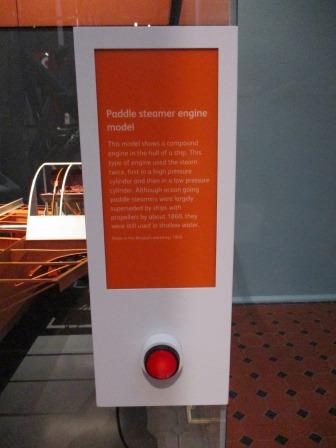One of the greatest attractions at National Museums Scotland is its working models, such as the Paddle Steamer Engine. It is no surprise that the busiest places in the museum are where working examples of such models are located.

However, have you ever thought about what happens when you push one of the big red buttons that makes them run?
In the past, pushing a button operated a simple timer that ran the model for a set time. However, faults inevitably developed on the buttons, with wiring and timers that occasionally resulted in damage to the models themselves. What was required was a timer (now called a controller), that would continually monitor the exhibit and all the components and wiring that make the model run. If a problem is detected it would shut the exhibit down and give an indication that something was wrong.
As a volunteer with the Collections Services team since 2012, my role is to work with the conservation staff Alex Walton and Stuart MacDonald, and one of my tasks was to assist with the design, build and installation of these new in-house controllers. Once they had specified what they required the controller to do, I was able to design a programme, specify components and manufacture the boxes for the working models to deliver some of the main functions to:
- run the models for a time period that is adjustable per model, and if the buttons are continually pushed or held in, the period that the model runs will not increase, thus protecting the model from running continuously.
- insert a random time period after each run to ensure the model does not stop in the same place every time, so that no one component of the model is disproportionately worn out.
- insert an adjustable cooling down period after each run to allow the motor and model to cool down.
- generate a maintenance warning so that the model can be cleaned and lubricated, providing long term protection for the exhibit.
- only permit the models to run during the period when the museum is open to the public, turning the power off when the museum is closed.
- enable detection of a faulty button and/or faulty wiring that would cause the model to run continuously or not at all.
- provide a warning and visual indication when any of the above faults are detected and shut down the model, enabling repair before the public have to report the fault.
- provide the capability for maintenance personnel to run the model to a specific position to aid lubrication, maintenance and repair.
The Collections Services team has also been able to connect remotely to the controllers from the National Museums Collection Centre in order to monitor the models remotely and ensure all are working correctly with no faults. The controllers can provide a ‘slow start’ function for models that use a friction drive to stop the motor from slipping on startup, which could cause damage to the models. After a power failure, the controller will detect if a model is not in its ‘home position’ and ensure it returns to this position, before its next run.
This is why I enjoy volunteering with Collections Services and the great team of staff so much. I am able to really utilise my skills in a very productive way, and feel very pleased that National Museums is so proud of the controller, and that it was designed in-house. In the short period of a year since being installed, the controllers have proved invaluable in protecting and saving the models from serious harm while conserving them for the future generations – which is what we are all about!